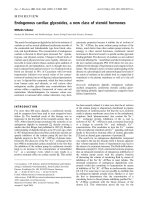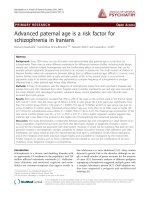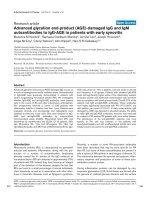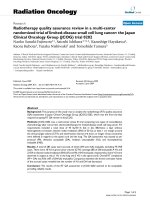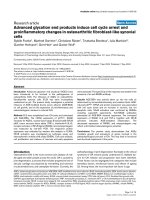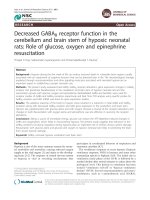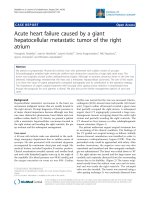Báo cáo y học: " Advanced Cardiac Resuscitation Evaluation (ACRE): A randomised single-blind controlled trial of peer-led vs. expert-led advanced resuscitation training" ppsx
Bạn đang xem bản rút gọn của tài liệu. Xem và tải ngay bản đầy đủ của tài liệu tại đây (256.53 KB, 6 trang )
ORIGINAL RESEARCH Open Access
Advanced Cardiac Resuscitation Evaluation
(ACRE): A randomised single-blind controlled trial
of peer-led vs. expert-led advanced resuscitation
training
Thomas C Hughes
1*
, Zoeb Jiwaji
2
, Kamaldeep Lally
2
, Antonia Lloyd-Lavery
2
, Amrit Lota
2
, Andrea Dale
2
,
Robert Janas
1
, Christopher JK Bulstrode
1
Abstract
Background: Advanced resuscitation skills training is an important and enjoyable part of medical training, but
requires small group instruction to ensure active participation of all students. Increases in student numbers have
made this increasingly difficult to achieve.
Methods: A single-blind randomised controlled trial of peer-led vs. expert-led resusci tation training was performed
using a group of sixth-year medical students as peer instructors. The expert instructors were a senior and a middle
grade doctor, and a nurse who is an Advanced Life Support (ALS) Instructor.
A power calculation showed that the trial would have a greater than 90% chance of rejecting the null hypothesis
(that expe rt-led groups performed 20% better than peer-led groups) if that were the true situation. Secondary out-
come measures were the proportion of High Pass grades in each groups and safety incidents.
The peer instructors designed and delivered their own course material . To ensure safety, the peer-led groups used
modified defibrillators that could deliver only low-energy shocks.
Blinded assessment was conducted using an Objective Structured Clinical Examination (OSCE). The checklist items
were based on International Liaison Committee on Resuscitation (ILCOR) guidelines using Ebel standard-setting
methods that emphasised patient and staff safety and clinical effectiveness.
The resul ts were analysed using Exact methods, chi-squared and t-test.
Results: A total of 132 students were randomised: 58 into the expert-led group, 74 into the peer-led group. 57/58
(98%) of students from the expert-led group achieved a Pass compared to 72/74 (97%) from the peer-led group:
Exact statistics confirmed that it was very unlikely (p = 0.0001) that the expert-led group was 20% better than the
peer-led group.
There were no safety incidents, and High Pass grades were achieved by 64 (49%) of students: 33/58 (57%) from the
expert-led group, 31/74 (42%) from the peer-led group. Exact statistics showed that the difference of 15% meant
that it was possible that the expert-led teaching was 20% better at generating students with High Passes.
Conclusions: The key elements of advanced cardiac resuscitation can be safely and effectively taught to medical
students in small groups by peer-instructors who have undergone basic medical education training.
* Correspondence:
1
Emergency Department, John Radcliffe Hospital, Oxford OX3 9DU, UK
Hughes et al. Scandinavian Journal of Trauma, Resuscitation and Emergency Medicine 2010, 18:3
/>© 2010 Hughes et al; licensee BioMed Central Ltd. This is an Open Access article distributed under the terms of the Creative Commons
Attribution License ( which permits unrestricted use, di stribution, and reproduction in
any medium, provided the original work is properly cited.
Background
Oxford University Medical School runs a traditional
medical school curriculum: three years of pre-clinical
training followed by three years of clinical training. All
students undergo Basic Life Support (BLS) training in
their fourth year. In year five, students have an eight-
week module of Musculoskeletal and Emergency Medi-
cine. As part of this module the students learn the core
skills of advanced resuscitation. Sixth year students
complete a full Advanced Life Support (ALS) course.
The students’ resuscitation skills are tested in an
Objective Structured Clinical Examination (OSCE), per-
formed on week seven of the eight-week course. I f stu-
dents do not pass this OSCE, they may repeat the OSCE
that d ay and may ‘pass with rescue’. If the student still
does not pass despite this, the OSCE may be re-
attempted a few months later.
Increases in student numbers without a corresponding
increase in faculty have made teaching advanced resusci-
tation skills increasingly challenging. It is difficult for
one instructor to cope with groups larger than 10 stu-
den ts while continuing to ensure all students acquire of
the practical skills of defibrillation. An ini tial plan to
offer only peer-led resuscitation training to all students
was not possible due to resource limitations. It was
therefore decided to undertake parallel teaching sessions
run by experts and peer-instructors, which facilitated a
randomised controlled trial.
Methods
The peer instructors were volunteers recruited from the
group of final-year students who had undertaken the
two day University of Oxford Special Study Module in
Medical Education. The peer instructors devised the for-
mat, content and structure of the teaching, but the aims
were specified:
By the seventh week of the course all students must
be able to:
- assess a collapsed patient for breathing and
circulation.
- perform basic cardiopulmonary resuscitation.
- initiate advanced resuscitation according to the
ILCOR guidelines.
- defibrillate safely and effectively using a manual
defibrillator.
- recognise and treat ventricular arrhythmias asso-
ciated with cardiac arrest.
These aims were specified because the time was lim-
ited (three hours vs. two days for a full Advanced Life
Support/Advanced Cardiac Life Support course). Cur-
rent evidence suggests that amongst patients with a car-
diac cause for cardiopulmonary arrest, ventricular
arrhythmias treated early with defibrillation are the
patient group most likely to recover to full function fol-
lowing successful treatment [1,2].
The practical skills teaching session lasted 90-120
minutes, and followed a 40 minute lecture on the
underlying pathophysiology of cardiac arrest and its
treatment which was performed by the same senior doc-
tor (TCH) each time. A 45 minute revision session was
also provided the day before the OSCE, which was con-
ducted in the same groups, and a t this stage a copy of
the OSCE scenario was distributed to all groups.
Safety
The peer instructors were not directly supervised, as this
would have confounded the trial. A senior doctor was
always within 20 metres of the room when th e defibril-
lators were being used. Rath er than use standard defi-
brillators, two defibrillators were bought and modified
to be able t o only give a 2 Joule shock, whatever energy
was selected. While no level of sh ock would be co mple-
tely free of danger, a two Joule shock would be the ther-
apeutic dose recommended in a 500 gram baby. A small
shock is necessary to activate the mannequins - Laerdal
Mega-Code Kelly (Laerdal Medical Limited, UK).
A further safety measure was the use of clip-on elec-
trodes rather than the hand-held defibrillation paddles.
This was consistent with local defibrillation policy. The
defibrillators were marked clearly to show that they
were not to be used for therapeutic use, and were kept
in a locked room away from clinical areas.
Outcome measures
The primary outcome measure was:
• proportion of first-time Pass grades
Secondary outcome measures were:
• proportion of High Passes grades
• safety issues during the OSCE
• safety incidents during training
Statistics and Ethics
A power calculation was done before starting the study
to ascertain whether sufficient numbers of students
wouldbeabletoberecruitedtodetectanimportant
difference between the groups, if one we re to exist. This
minimum important difference to detect was decided by
the group to be 20%. The pass rate from previous
groups taking the OSCE was 90-95%. The null hypoth-
esis (w hich we sought to reject) was therefore that the
pass rate from the peer group would b e 20% inferior to
that of the expert-led group.
The calculation assumed 60 students in each group,
examining for non-inferiority of the peer-led group
using a one-tailed test with an alpha value of 0.05 (a 5%
chance of wrongly accepting the hypothesis), the power
of the study was 93%. This means that there was a 93%
chanceofafindinga20%differencebetweenthetwo
groups, were one to exist.
Hughes et al. Scandinavian Journal of Trauma, Resuscitation and Emergency Medicine 2010, 18:3
/>Page 2 of 6
Statistical analysis was carried out using StatExact v8.0
(Cytel Inc) and SPSS v.14 (SPSS Inc). Ethical approval
for this study was obtained th rough the University of
Oxford Central University Research Ethics Committee.
Allocation, randomisation and blinding
The average size of groups that ro tate between different
specialties in the fifth year of traini ng is 28 st udents. As
outlined above, limitations in space, equipment and
teaching staff meant that it was not possible to run a
direct comparison of similar group sizes, and therefore
the decision was made to limit the maximum size of the
peer-led groups to eight students. This potent ially
reduces the validity of the comparison, but is a reflec-
tion of the ‘convenience sample’ available, and it was
thought that having to manage a large group would be
quite intimidating for peer instructors who had l ittle
previous experience of such situations.
Randomisation was achieved using a program written
in Filemaker Pro (Filemaker Inc.), which enabled group
size restrictions on the peer-led group to be met. Stu-
dents were allocated to groups and the same groups
were used for the revision session prior to the OSCE.
Assessment was blinded: the OSCE assessor (either
consultant or middle grade doctor) did not know in
which group the student had received their training.
The Advanced Resuscitation Scenario OSCE checklist
(see additional file 1) is closely based on the ILCOR (Inter-
national Liaison Committee on Resuscitation) guidelines
[3]. The scenario starts by testing basic resuscitation skills,
and progresses to test advanced resuscitation skills includ-
ing defibrillation. The ventricular arrhythmi as used were
ventricular fibrillation, ventricular tachycardia and tor-
sades des pointes. The students were not expected to iden-
tify the arrhythmia, only whether or not it needed
immediate defibrillation. The ability to differentiate
arrhythmias needing defibrillation from others was tested
in a written exam taken in the same week.
A pass mark was awarded if the student achieved 23/
25 marks and did not perform any unsafe actions such
as:
• charging the defibrillator/discharging the defibrillator
without intending to do so.
• failing to warn others of defibrillation.
• failing to visually check that no one was touching
the mannequin.
• touching the mannequin or the surface on which the
mannequin was placed.
A high pass mark required 25/25 marks including all
four components of sections 24 and 25, with no
hesitation.
The peer-led g roups were smaller with a median of
seven students per group compar ed to 12 in the expert-
led group. This was possible because the peer instruc-
tors were not drawn from the E mergency Department
staff a nd therefore there was no cost to the Emergency
Department (other than the one-off equipment costs).
Results
Five ro tation groups of students, totalling 132 students
were entered into the trial: 74 in the peer-led and 58 in
the expert-led group. No students dropped out of the
trial. The median rotation group size was 26 (range 25-
28), which on average gave one expert-led group o f 12
students, and two peer-led groups of seven students
(Figure 1: Consort Diagram)
Passes were achieved in the OSCE by 72/74 (97%) in
the peer-led group and 57/58 (98%) in the e xpert-led
group. Exact testing confirms t hat the null hypothesis
(that the expert-led group was 20% better than the peer-
led group) is rejected (one-sided p < 0.0001). The upper
limit of the one-sided 95% confi dence limit is 6.5%, well
within the 20% limit.
High passes were achieved i n the OSCE by 31/74
(42%) in the peer-led group vs. 33/58 (58%) in the
expert-led group. Exact testing in this case does not
reject the null hypothesis (p = 0.286) as the upper limit
of the one-sided 95% confidence limit is 29.6%, and
therefore the true difference could exceed the 20% non-
inferiority boundary.
No unsafe incidents (see above) related to defibrillation
occurred in either the peer-led or expert-led groups.
There was one complaint about the teaching quality. This
was from a student in one of the expert-led groups want-
ing to be moved to one of the peer-led groups.
Expert comparison: Senior Doctor vs. Middle-grade
Doctor vs. Nurse Instructor
The subgroup analysis for the H igh Passes is presented,
but due to the small numbers within these group and
Figure 1 CONSORT diagram for ACRE study.
Hughes et al. Scandinavian Journal of Trauma, Resuscitation and Emergency Medicine 2010, 18:3
/>Page 3 of 6
known hazards of post-hoc statistical analysis, these data
should be treated with caution.
All students except one from the nurse-led group
passed. For the High Pass grades in:
• the senior doctor/consultant group 6/12 (50%)
attained High Passes.
• the middle grade doctor group 11/22 (50%) atta ined
High Passes.
• the nurse group 16/24 (67%) attained High Passes
Analysis of these results did not indicate significant
inter-group variation in the proportions awarded Pass
(Chi Squared p = 0.472) or High Pass grade (Chi
Squared p = 0.213).
Discussion
Training need
Defibrillation using automated and non-automated defi-
brillation is part of the undergraduate acute care curri-
culum as defined by the ACUTE Delphi survey [4].
Students consistently name the advanced resuscitation
training as one of the most enjoyable parts of the Mus-
culoskeletal and Emergency Medicine course.
Peer-led teaching has been successfully incorporated
into medical school, and has been used successfully to
teach Basic Life Support [5]. Peer-led teaching also
appears to have benefits for the peers who act as tea-
chers [6]. The peer-instructors had completed the Medi-
cal Education Special Study Module, which included
guidance on giving practical instruction and feedback.
The practice of resuscitation is very much al ong beha-
vioural (stimulus-response) lines, and is assessed using a
behavioural assessment tool - the Objective Structured
Clinical Examination. Advanced resuscitation, like basic
resuscitation is just the chaining of a number of stimu-
lus-response actions.
Advanced resuscitation training involves the use of a
defibrillator, and it is likely that this has been the barrier
to peer-led training in this area. Using de fibrillators that
have been modified to ensure no possibility of inadver-
tent full-energy discharge minimises any risk. The
change in defibrillation practice using self-adhesive pads
rather than the hand-held paddles beloved of televised
emergency drama has also reduced the risk of inadver-
tent defibrillation of staff.
Study Design
When this study was first mooted, the question came
back “Should medical students be teaching advanced
resuscitation to each other at all?” Arguments against
allowing students to act as peer instructors centred on
either pra ctical issues such as safety and supervision or
lack of relevant experience of the peer-instructors.
These arguments were particularly vocal from those
employed to teach advanced resuscitation.
The first of these objections was answered by using
the modified defibrillators and ensuring readily availabl e
senior medical supervision. Advanced Life Support
courses have used non-medically qualified i nstructors
for many years. The number of resuscitations that th ese
instructors may have led as the main decision-maker
will be quite variable. As mentioned above, because the
practice of resuscitation is completely protocol-driven,
there is no reason that lack of direct experience should
be a bar to teaching a practical skill dictated by stimu-
lus-response actions. The theory and evidence base that
underpins resuscitation was explained in the 40 minute
lecture prior to the practical training.
The peer-led groups were smaller than the expert-led
groups. This was a fair comparison as there is no cost
barrier to having smaller groups with peer-led instruc-
tion, other than one-off equipment costs. However it
could be argued that the difference in group size con-
founded the results.
Judging the quality of educational interventions is diffi-
cult. Rather than outcomes, educational studies often use
evaluation data from students that is more easily collected
and analysed, but much less valid as a judgement of qual-
ity. The ultimate test of this intervention would be to mea-
sure the number of patients resuscitated by the different
groups, but this would not be feasible.
Randomised controlled trial
Randomi sed controlled trials are uncommon in medical
education [7]. This study was easy to s et up as studen ts
were already being randomly allocated to the different
groups before the study started. The performance of the
study therefore did not disadvantage the students in any
way.
The most methodologically pure way of assessing the
relative worth of any teaching would be the inclusio n of
a control group who had no teaching at all. However
this plan would almost certainl y be confounded because
peer-led instruction would occur anyw ay, but would be
likelytobeinconsistentandwoulddisadvantagethose
who, for whatever reason, found peer-led instruction dif-
ficult to arrange.
Power
The power of a study is th e chance of incorrectly reject-
ing the null hypothesis - i n this case d etecting non-
inferiority, when this is the reality. In this case the null
hypothesis was that t he Pass rate from expert-led teach-
ing would be 20% s uperior to that from peer-led teach-
ing. By performing the calculation at the design stage,
we could be sure that we could recruit enough students
to be reasonably sure that we could to answer this ques-
tion. This study had a greater than 90% chance of
detecting non-inferiority (inthiscaseby20%)ifinfact
this were the case.
Hughes et al. Scandinavian Journal of Trauma, Resuscitation and Emergency Medicine 2010, 18:3
/>Page 4 of 6
The OSCE checksheet appeared sensitive enough to dis-
criminate between candidates as previous groups of stu-
dents had a Pass rate of approximately 90-95%. It could be
argued that the Pass rate, which was higher than expected
in both groups, is a result of Hawthorne Effect. However
multiple subsequent groups (after t he trial had finished)
have had maintained this high Pass/High Pass rate, sug-
gesting that this is not the explanation.
Validity and reliability
Content Validity
The content of the Advan ced Resuscitation Scenario
OSCE checksheet used has been gradually refined over
several years of use i n assessing medical students and
junior doctors. The OSCE has changed as more/better
quality evidence becomes is available and is synthesised
by ILCOR into clinical protocols and guidelines.
Content validity was ensured by matching the actions
to the ILCOR protocols and by incorporating the evi-
dence about situations most likely to have positive out-
comes in real-world resuscitation. The OSCE checksheet
items were structured with particular emphasis on
operator and patient safety and clinical effectiveness.
Concurrent Validity/Reliability
Concurrent validity of the OSCE checklist was pre-
viouslyestablishedbymeasuringtheinter-observer
variability (kappa) of th e form as a whole (pass/fail), and
also individual el ements within the form, although the
form has evolved since that time to reflect the changes
made by ILCOR to the resuscitation protocol in 2005.
Predictive validity
Predictive validity, while the most important outcome, is
very difficult to prove in any study of resuscitation train-
ing. This is because the clinical outcomes would be
impossible to measure in a way that was ethical, valid
and reliable. There is evidence from large-scale trials
that training in CPR does make a significant difference
to patient survival [8].
External Validity
There is nothing in the design or execution of this study
that would preclude the technique being used elsewhere.
The OSCE checksheet is included as an additional file
and may be freely used, copied and distributed, p rovid-
ing the source is acknowledged - see the terms of the
Creative Commons licence.
Evaluation
Group specific evaluation data is not available, but anon-
ymised evaluation forms were collected for the groups.
The evaluations of the ALS teaching b y the different
groups throughout the year (2007-8) were compared with
those from the previous year (2006-7) when peer-led
teaching was not used. The evaluation rating was in a
range from to one to five, five being the highest.
For the year of the study (2007-8) the mean and SD
were 3.92 and 0.41 compared with a 3.83 and 0.59 for
the previous year. This difference was not significant (T
test for independent samples p = 0.91).
Why the difference in High Pass rates?
There are many possible explanations for the experts
havingahigherHighPassrate:itmaybethatthe
experts, and particularly the nurse, who appears respon-
sible for this difference:
• spent more ‘hands-on’ time rather than theory dis-
cussion of ECGs.
• was better at teaching the nuances of ‘excellent’
rather than just ‘very good’ resuscitation or
• was a more demanding teacher or
• had more experience of conducting OSCEs and
therefore was better able to prepare the students.
Alternatively it may be that the p eer-teachers, who
were aware that the results of their teaching was being
measured, concentrated on making sure that all their
students would obtain a Pass grade.
Should this course and OSCE replace the ALS course?
The arguments and evidence stated ab ove could be taken
to suggest that there is no need for a formal Advanced
Life Support (ALS) course, as this short course could
equip students with the key knowledge and skills t o deal
with the emergencies that they are most likely to see and
successfully treat. If no definitive course were available,
then this would be a sensible arrangement.
However the current arrangement fits well within the
model of spiral learning whereby the students learn Basic
Life Support in the first clinical year, have this reinforced
in the fifth year with the above course that teaches the
most important elements of advanced resuscitation, and
culminates with a full ALS course in the final year. This
structure is particularly important for resuscitation train-
ing, as there is a high rate of skills attrition in resuscitation
training [9], probably due to the lack of concrete experi-
ence to re-enforce the learning on such courses.
Conclusions
There are caveats about the generalisabilty of this
study’s results, in that
• the numbers of students in the peer-led groups was
limited to 7 for reasons explained above.
• the peer teachers had completed a Special Study
Module (SSM) in medical education.
However, with these caveats, this study shows that
senior medical student peer-instructors can safely and
effectively teach core advanced resuscitation skills to
more junior medical students.
Additional file 1: The ACRE resuscitation OSCE Checksheet in Rich
Text Format in A4 size.
Click here for file
[ />S1.RTF ]
Hughes et al. Scandinavian Journal of Trauma, Resuscitation and Emergency Medicine 2010, 18:3
/>Page 5 of 6
Acknowledgements
Particular thanks go to:
Jackie Webster who organisers the Musculo-skeletal and Emergency
Medicine course who co-ordinated the teaching sessions and OSCEs
Tim Lancaster, Director of Clinical Studies University of Oxford, for his
support of peer-led teaching and this research.
Derek Roskell, Assistant Medical Director (Education) for arranging the
funding for the equipment that made this study possible.
Janette Hughes, who assisted with the statistical analysis.
Author details
1
Emergency Department, John Radcliffe Hospital, Oxford OX3 9DU, UK.
2
University of Oxford Medical School, John Radcliffe Hospital Oxford OX3
9DU, UK.
Authors’ contributions
TCH conceived of this study, performed the analysis and prepared the
manuscript.
ZJ, KL, AL-L, AL designed and implemented the peer-led teaching
programme and contributed to the study design.
AD and RJ participated as expert instructors, contributed to the study design
and prepared the figures.
CJKB conceived of the peer-led teaching programme, taught the peer
instructors on the Med Ed SSM and arranged equipment necessary for this
trial.
All authors read and approved the final manuscript.
Competing interests
The authors declare that they have no competing interests.
Received: 2 April 2009
Accepted: 14 January 2010 Published: 14 January 2010
References
1. Norris RM: Circumstances of out of hospital cardiac arrest in patients
with ischaemic heart disease. Heart 2005, 91(12):1537-1540.
2. Brindley PG, Markland DM, Mayers I, Kutsogiannis DJ: Predictors of survival
following in-hospital adult cardiopulmonary resuscitation. CMAJ 2002,
167(4):343-348.
3. 2005 American Heart Association Guidelines for Cardiopulmonary
Resuscitation and Emergency Cardiovascular Care. Circulation 2005,
112(24 Suppl):IV1-203.
4. Perkins GD, Barrett H, Bullock I, Gabbott DA, Nolan JP, Mitchell S, Short A,
Smith CM, Smith GB, Todd S, Bion JF: The Acute Care Undergraduate
TEaching (ACUTE) Initiative: consensus development of core
competencies in acute care for undergraduates in the United Kingdom.
Intensive Care Med 2005, 31(12):1627-1633.
5. Perkins GD, Hulme J, Bion JF: Peer-led resuscitation training for
healthcare students: a randomised controlled study. Intensive Care Med
2002, 28(6):698-700.
6. Buckley S, Zamora J: Effects of participation in a cross year peer tutoring
programme in clinical examination skills on volunteer tutors’ skills and
attitudes towards teachers and teaching. BMC Med Educ 2007, 7:20.
7. Torgerson CJ: Educational research and randomised trials. Med Educ 2002,
36(11):1002-1003.
8. Stiell IG, Wells GA, Field BJ, Spaite DW, De Maio VJ, Ward R, Munkley DP,
Lyver MB, Luinstra LG, Campeau T, et al: Improved out-of-hospital cardiac
arrest survival through the inexpensive optimization of an existing
defibrillation program: OPALS study phase II. Ontario Prehospital
Advanced Life Support. JAMA 1999, 281(13):1175-1181.
9. Woollard M, Whitfield R, Newcombe RG, Colquhoun M, Vetter N,
Chamberlain D: Optimal refresher training intervals for AED and CPR
skills: a randomised controlled trial. Resuscitation 2006, 71(2):237-247.
doi:10.1186/1757-7241-18-3
Cite this article as: Hughes et al.: Advanced Cardiac Resuscitation
Evaluation (ACRE): A randomised single-blind controlled trial of peer-led
vs. expert-led advanced resuscitation training. Scandinavian Journal of
Trauma, Resuscitation and Emergency Medicine 2010 18:3.
Publish with BioMed Central and every
scientist can read your work free of charge
"BioMed Central will be the most significant development for
disseminating the results of biomedical research in our lifetime."
Sir Paul Nurse, Cancer Research UK
Your research papers will be:
available free of charge to the entire biomedical community
peer reviewed and published immediately upon acceptance
cited in PubMed and archived on PubMed Central
yours — you keep the copyright
Submit your manuscript here:
/>BioMedcentral
Hughes et al. Scandinavian Journal of Trauma, Resuscitation and Emergency Medicine 2010, 18:3
/>Page 6 of 6



